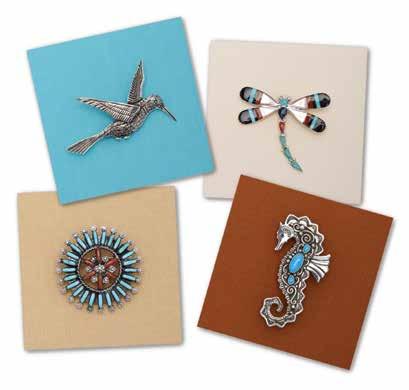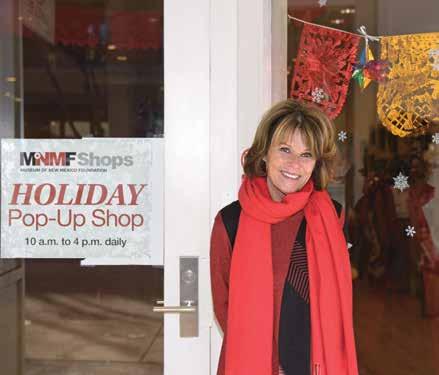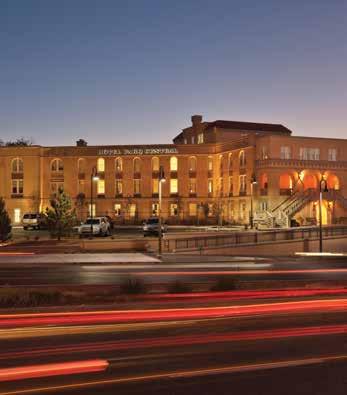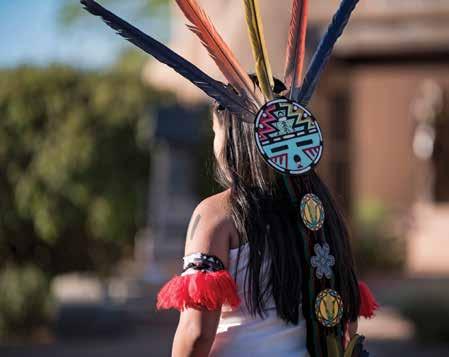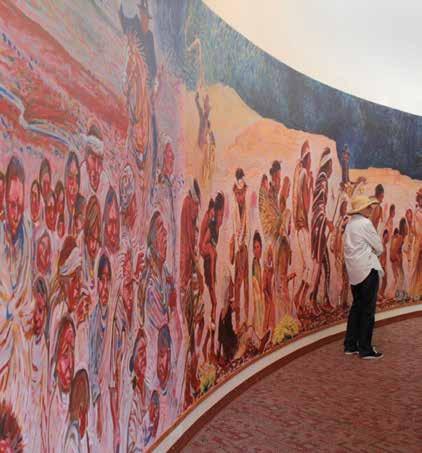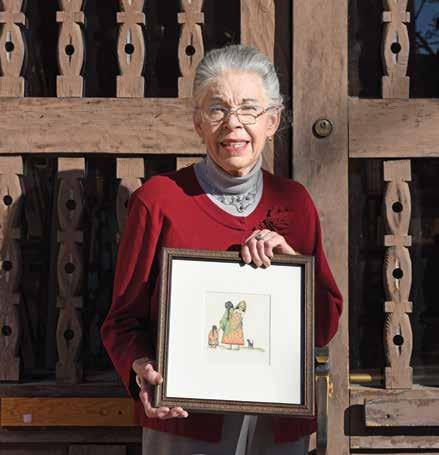
11 minute read
SHOPS AND LICENSING
It was a miracle on Lincoln Avenue.
Last fall, the Museum of International Folk Art and Museum of Indian Arts and Culture shuttered in response to pandemic-related state health orders. Their respective shops closed, too. A local family with deep roots in the real estate community offered free downtown retail space. A pop-up museum shop arose on Lincoln Avenue—just in time to save Christmas.
The Holiday Pop-Up Shop is one example of how the Museum of New Mexico Foundation’s four dynamic museum shops have worked to stay robust despite the commercial ravages wreaked by COVID-19. Thanks to social media marketing and nonprofit networking, online sales are booming in broader markets, benefiting the Foundation’s brick-and-mortar and online shops. The hard work and enthusiasm of staff, including James Wood and Simone Ward in the Shops warehouse and the entire team of sales associates and volunteers, made these successes possible.
Even so, economic uncertainties prompted the Foundation to take a conservative approach. During the traditionally slow winter retail season between January and March, the Shops paused in-person shopping and shifted exclusively to online sales at shopmuseum.org. On-the-ground retail spaces are expected to reopen in April.
The Foundation’s distinguished Licensing program has also held strong in the face of international supply chain delays. The program’s wholesale partners have rolled out an impressive four new product lines inspired by museum collections over the past six months.
The earned income from both Shops and Licensing—$2.4 million and $133,000, respectively, in the last fiscal year—supports the Foundation in shoring up its four Santa Fe museums, eight historic sites statewide and the Office of Archaeological Studies. But the goals behind the two programs are aimed at more than pure profit. Bringing awareness to museum collections and forging lasting relationships with consumers are of equal importance, along with one trailblazing rule that can best be summed up as “inspiration, not replication.”
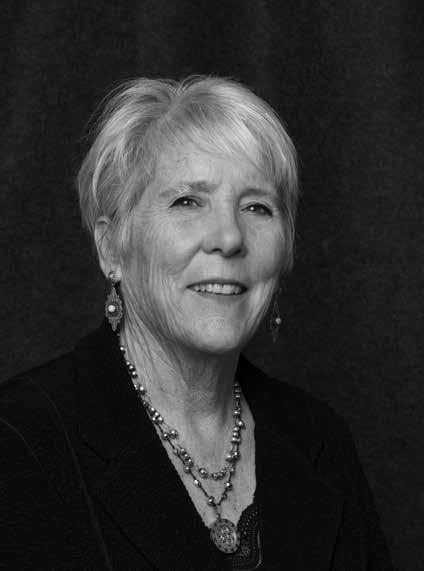
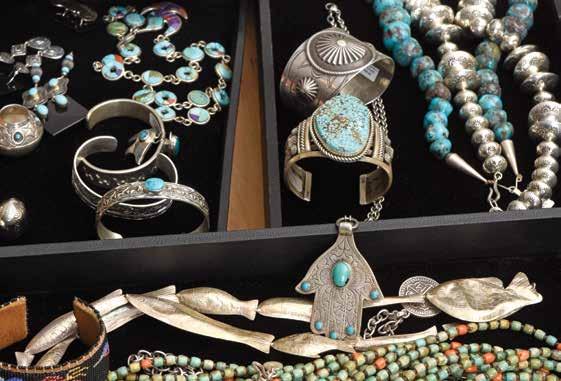
Foundation President/CEO Jamie Clements explains the philosophy behind each program. “We use the Shops to enhance visitor experiences, and Licensing to advance our collections,” he says. “Bringing exposure to our museums and collections is the greater goal.”
Keeping Retail Relevant
Sara Birmingham, the Foundation’s vice president of retail, stresses the importance of flexible thinking when it comes to buying and selling museum-related merchandise.
“If the electricity goes off, we get out the flashlights,” she laughs. “In retail, it’s always thinking what’s going to come next.” About the pandemic, the former Nordstrom buyer says, “This has been the worst ‘next’ I’ve ever experienced.”
Birmingham’s seasonal buying trips may have temporarily been relegated to Zoom calls, but she sticks to the building blocks of the retail process, beginning with a budget. “It’s how much inventory you should own based on the space you have and the volume of sales you project for a year. The higher the turn of merchandise over that year, the more efficient you are as a buyer,” she says.
With her assistant buyer, Kylie Strijek, Birmingham assesses both the minimum and maximum of merchandise she can fit into a store space, assigning a budget to each department: books, cards, stationery, jewelry, apparel, children’s items, accessories. Then the real critical thinking begins. “What is the best price for this product? What’s the perceived value? Is it a fair price for the customer and the maker? How much will an eventual markdown affect our bottom line?” Birmingham explains.
First priority, as it has been since the Shops program began in 1965, is purchasing works from New Mexico artists, artisans and makers. In the case of the Museum of International Folk Art Shop, Birmingham also seeks out international vendors with quality products. All told, the Shops contribute substantially to the local-global creative economy, serving as a sales and marketing venue for nearly 1,000 artists and artisans statewide, as well as for 400 international artists.
Enhancing the Visitor Experience
Birmingham keenly understands the role of the Shops in serving the vision—and the visitors—of their respective museums. She works with museum planning teams for exhibitions, paying close attention to tying products to the themes of the exhibitions on view.
For example, for the Folk Art Museum’s 2015 exhibition The Red That Colored the World, Birmingham sought vendors who used cochineal insect dye in their products—including a Taos cosmetics company and a sock-maker from Truth or Consequences. The shop, conveniently the first sight for visitors to the museum, “turned red, too,” she says, becoming a sort of exhibition in itself. The display inspired visitors to delve deeper into the experience of the color red.
Above left: Sara Birmingham, vice president of retail, provides buying and sales expertise to select the extraordinary range of goods offered by the Shops. Above right: A selection of Native jewelry sold at the Museum of Indian Arts and Culture’s Colleen Cloney Duncan Shop. Photos © Saro Calewarts.


When she’s assessing an item for inclusion in a shop, Birmingham rifles through a mental Rolodex of everyone she knows. “If I can’t think of one person who would buy it, I pass on it,” she says. The driving idea behind every item is the goal of forging a lasting connection between the customer and the museum, along with increasing the possibility of a return visit—whether it’s in person or online.
“The person who spends a half day at the History Museum is not necessarily the same person who visits the Folk Art Museum. The inspiration within those walls is what you hope will motivate them to possibly take home a remembrance of their visit. It connects them to us. It’s more about the feeling and experience you have in a place rather than what you purchase.”
Making the Most of Modern Marketing
Marketing and advertising have changed significantly since the old days of local advertising in magazines and newspapers. Now, the Foundation uses Shopify to run its Shops website—shopmuseum.org—and advertises through sites like Facebook, Pinterest, Instagram and Google. The social media reach is instantaneous and vast.
“I can decide right now that I want to promote some new jewelry and then we quickly promote it on social media,” Birmingham says. “In the past, you’d hire a professional photographer, build an advertising platform, print a catalog and mail it. Truly, marketing has become more accessible and less expensive for the retailer.”
The Shops have also expanded their reach this year through the Foundation’s partnership with 10 national museums, including the Boston Museum of Fine Arts and the de Young Museum in San Francisco. This enables the Shops to advertise and share discounts with museum members beyond the Museum of New Mexico system. The effect has been immediate: orders have flown into shopmuseum.org from such far-flung markets as New England, Virginia and Florida. This has translated to an estimated $38,000 in increased online sales for the Shops.
Museum Best Buys
Exhibition-related products come and go, but each shop boasts a set of perennial bestsellers. Some are no-brainers: jewelry sales account for half of all Shops profits, Birmingham says, stressing the importance of rotating the selection. New Mexico history and literature books always sell well to visitors wishing to learn more about local art and culture at home or in their hotel rooms.
But it just might be one certain $48 faux-ostrich-leather handbag that best illustrates the benefit of Birmingham’s painstaking assessments of every item she selects. “I think every woman in Santa Fe has that bag,” Birmingham laughs. “It has a top zippper, so it’s functional for travel and safety. It just shows you that function is as important as design.”
Above left: Retail vice president Sara Birmingham (left) and assistant buyer Kylie Strijek process the popular faux ostrich handbags at the Shops warehouse. Above right: Vibrant Iznik pottery, handcrafted in Turkey, is a perennial customer favorite. Photos © Saro Calewarts.


Birmingham points to a couple of brand new items in the Museum of Art and History Museum shops that meet the current moment with form and function: face masks featuring designs inspired by artists Gustave Baumann and others. The key words are “inspired by,” she says, noting that the Foundation steers clear of replication.
Adapting Museum Designs
When it comes to showcasing the rich design legacy of the Museum of New Mexico collections, the Licensing program does its share of heavy lifting.
Top of mind for Pamela Kelly, the Foundation’s vice president of licensing and brand management, are the ways in which museum collection items can connect to a broader audience. Such connections are on display in the Licensing program’s New West collection of furniture and home accessories, just released by Studio A and available to view online at studioa-home.com/brand-partners/new-west.
Objects in the collections of the Museum of International Folk Art and Museum of Indian Arts and Culture—including German ceramics, furniture from North Africa and Spain, raffia textiles from the Kuba people of the Democratic Republic of Congo, and Native American pottery and basketry—sparked the collaboration with Studio A. The New West line of vases, keepsake boxes, beaded pillows, mirrors and other items reflects this lineage of design heritage. The resulting objects range from a white ceramic vase with a raffia pattern to a console adorned with tiles featuring petroglyph-like designs.
The New West collection, as well as three other collections introduced over the last six months, are the latest in the diverse design lines created since the Licensing program was established in 1998. Kelly’s international partnerships with manufacturers who draw design inspiration from cultural artifacts in museum collections have since become a vital and lasting extension of the Museum of New Mexico’s design legacy.
“The world has kind of caught up with us. When we were first bringing things to market, the whole idea of craft and folk cultures was pretty new,” says Kelly. “We were early with this idea of telling the world about beautiful design traditions from cultures around the world and in New Mexico.”
Art and Access
Kelly explains that the Foundation’s license gives a manufacturer access to two things: the Museum of New Mexico brand and a collection from which to draw design inspiration. The word “inspiration” is as key to Licensing as it is to the Shops, as licensees are never allowed to exactly replicate designs from museum artifacts. This protective policy ensures that museum collections are shared to respectfully showcase and educate the public about the cultures they represent.
Above left: Seed Beaded Pillow, from the New West collection by Studio A. Photo courtesy Studio A Home, a Global Views Company. Above right: Pamela Kelly, vice president of licensing and brand management, launched the Museum of New Mexico Foundation’s Licensing program in 1998. Photo © Saro Calewarts.
From the outset of contracting with a manufacturer for an advance against royalties and a percentage (usually five to 10 percent) of net wholesale profits, the licensing process is intensely collaborative. It is loaded with checks and balances to ensure a faithful tribute to the original design.
“The product design process involves a fair amount of collaboration between museum curators, us and our licensees,” Kelly says. “However, the development of sales and marketing materials is our domain. How a product is named and explained is vital to us, so we manage that entire process.”
At the Museum of Indian Arts and Culture, for example, Kelly meets with the Indian Advisory Panel early on in the process to make sure a manufacturer’s vision is aligned with the museum’s educational goals. For the museum’s collaboration with West Elm on a line of handwoven rugs inspired by designs from the museum’s basketry and textile collections, Kelly says, “We went over every word in the catalog.”
Textile and rug designs have made up the majority of successful collaborations over the span of the program, though manufacturers are also frequently captivated by the intangible qualities of the cultures the museum collections reflect. The New West collection, for example, includes a line of beautifully beaded throw pillows featuring graphic and modern designs inspired by the dramatic landscape and natural world of the Southwest.
In Licensing, as in the Shops, close attention is paid to details of cultural preservation, contemporary design and savvy marketing. While the world of gift shows and in-person sales and product development has momentarily gone the way of the pandemic, the elements on which both programs are built—creativity, cultural diversity and inspired design—are resonating with the public more than ever in the virtual spaces of Shops and Licensing.
Rest assured, when the world opens up again, there will be new exhibition- and collection-inspired products to reconnect visitors with their favorite museums.
“The inspiration of our museums, and the innovation of the Shops and Licensing programs, is taking us beyond COVID-19,” says Clements. “We’re looking toward a new era of support.”
For information on the Shops, visit shopmuseum.org or contact Sara Birmingham at Sara@museumfoundation.org or 505.216.0725. For information on Licensing, visit mnmlicensing.org or contact Pamela Kelly at Pamela@museumfoundation.org or 505.216.0614.
Visit the Shops for Daily Member Discounts
The Museum of New Mexico Foundation Shops welcome all customers, but Foundation members receive discounts every day. Members get 10% off and The Circles save 15%. All members benefit from seasonal double discount sales. Visit our downtown and Museum Hill shops in Santa Fe when they reopen in April or shop online at shopmuseum.org.
DOWNTOWN
New Mexico Museum of Art Shop
107 West Palace Avenue 505.982.1131
Spiegelberg Shop at the New Mexico History Museum
113 Lincoln Avenue 505.982.9543
MUSEUM HILL
Colleen Cloney Duncan Shop at the Museum of Indian Arts and Culture
706 Camino Lejo 505.982.5057
Museum of International Folk Art Shop
706 Camino Lejo 505.982.5186
ONLINE
shopmuseum.org
Member Discounts
10% for members 15% for The Circles


